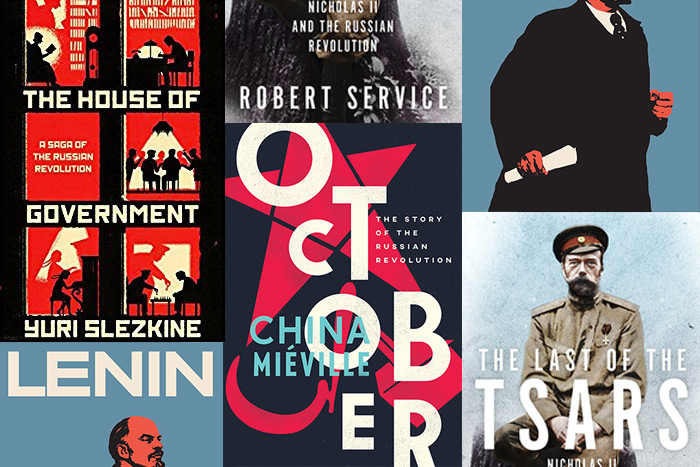100 Years Later: Four Books About the 1917 Russian Revolution

One hundred years ago today—November 7, 1917—what began as a celebration of International Women’s Day six months earlier culminated in the radical left government, led by Vladimir Lenin and his Bolshevik Party, taking complete power over the vast Russian Empire, nearly one-sixth of all the earth’s land, controlled for three centuries by the Romanov dynasty. Dozens of books have been published about the Russian Revolution this year in effort to explain the intricate and complex events of 1917. We’ve put together a short list of our favorites.

Perhaps a more apt title for China Mieville’s October: The Story of the Russian Revolution (Verso, $26.95), would have been 1917. Even so it would have been slightly confusing as the events of the book take place in a country then using the Julian calendar, as opposed to the Gregorian calendar we use today. As Mieville writes in his introduction, “In some of the literature one might read that the Winter Palace was stormed on 5 November 1917. But those doing the storming did so on the 26th of October.” The good news is that at no point during the examination of this infinitely complex period of time—from the weeks leading up to fall of the 300-year-old Romanov dynasty with the abdication of Nicholas II to the final Bolshevik overthrow of Kerensky’s Provisional Government—is a reader left scratching their head too much.
Mieville, perhaps best known for his fantasy science fiction works, brings a fresh and addictively readable style to the topic. With a novelist’s eye he fleshes out, month by month and day by day, a complex historical event with numerous characters, organizations, committees, intrigues, plots and subplots. A reader can, at times, it is true, become bogged down in detail. More often than not, though, the prose is crisp, clear and reads like a perfectly plotted political thriller. As a general introduction to the events surrounding the Russian Revolution, one would be hard pressed to find another retelling quite as entertaining, while being simultaneously informative. There is, for those who wish to follow more closely, a tremendously useful glossary of names, from Alexeev to Zinoviev, in the back of the book followed by a list of further recommended reading.

Lenin: The Man, the Dictator, and the Master of Terror (Pantheon, $35) by Victor Sebestyenis is not only a political examination of one of the most important historical figures of the twentieth century but also a fascinating portrait of Lenin the man and the first major biography of Lenin to appear in English in nearly two decades. Sebestyenis’ biography of Lenin takes on a lighter tone than other such endeavors, which compels the reader forward. Don’t let the ease of reading fool you, though. This is thoroughly researched and important book, which brings Lenin and his socialist comrades to life—from the violence and tyranny of the Tsarist regime that begat them, to the violent and tyrannical regime they would create. The stage is set with a recounting of the day—October 25 on the Julian calendar—when Lenin and his Bolshevik party seized power. Lenin had said, the author reminds us, that after “Glorious October” taking power was “as easy as picking up a flower.” Sebestyenis, after years of meticulous research, digging through previously locked-away Soviet archives and reading through the entirety of Lenin’s monumental Collected Works, then spends the next 600 pages proving just how long and hard that taking power actually was for this middle-class boy brought up with a passion for fishing, chess and the English classics, turned revolutionary.

No discussion of books related to the Revolution is complete without mentioning Robert Service. Best known for his trilogy of biographies of the founder figures of the Soviet Union—the simply titled Lenin, Trotsky and Stalin—his new book, The Last of the Tsars: Nicholas II and the Russia Revolution (Pegasus Books, $29.95), is a riveting account of the last eighteen months of Tsar Nicholas II’s life and reign and a compelling account of the social, economic and political ferment in Russia that followed the February Revolution, the Bolshevik seizure of power in October 1917 and the beginnings of Lenin’s Soviet socialist republic. Service delves into the Tsar’s personal diaries and recorded conversations, as well as the testimonies of the official inquiry to shed remarkable new light the Russian Revolution.

For something unlike anything else, there’s The House of Government: A Saga of the Russian Revolution (Princeton University Press, $39.95) by Yuri Slezkine. At 1,128 pages it’s a doozy, written in the tradition of Tolstoy’s War and Peace, Grossman’s Life and Fate, and Solzhenitsyn’s The Gulag Archipelago. The narrative tells the true story of the residents of an enormous Moscow apartment building where top Communist officials and their families lived before they were destroyed in Stalin’s purges. Completed in 1931, it’s a chilling story drawing on letters, diaries and interviews, featuring hundreds of rare photographs and weaving together biography, literary criticism, architectural history and fascinating new theories of revolutions, millennial prophecies and reigns of terror.
Purchase these books and more at your local bookstore.









